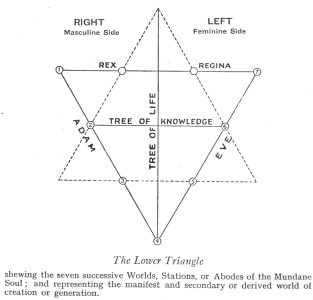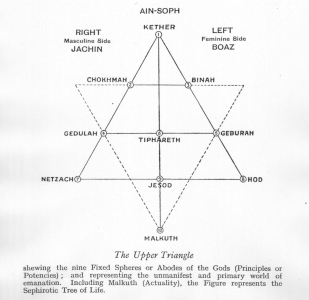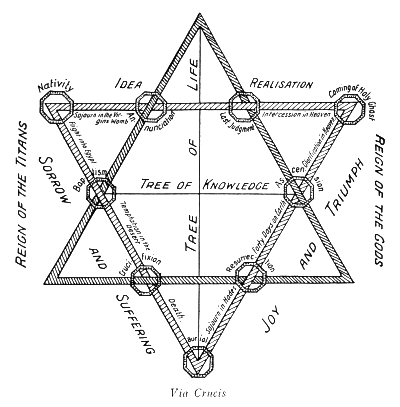|
(Article by Anna Kingsford from Light, 1882, republished in The Credo of Christendom, 184-90, with additional footnotes omitted.)
There is, generally, so much misapprehension as to the modus operandi of the soul’s progress, and consequently, so much warm contention between two sections of Spiritualists on the question, that I am moved, contrary to my custom, to write for public reading a brief recapitulation of the ancient and true doctrine on this important subject. This doctrine I first received, not from any extraneous or obsessing ‘spirit’ or ‘control,’ but from the divine and interior Spirit, concerning whom something will be said in this paper. Subsequently, I discovered that the revelation thus made to me was not new, but was contained and formulated in the Hebrew Kabalah, in Hindû philosophy, and not less clearly in the mysteries of Egypt and of Greece. Man is a twofold being, comprising in himself a celestial and terrestrial personality. The inner person—the celestial—is dual, and this duality is composed of Soul and Spirit. The outer personality is also dual, and is terrestrial and evanescent. Its component parts are Body and astral Shade. In the Kabalah the three first of these constituent elements of man are named, from within outwards—Jechidah (or Chokhmah), Neschamah, and Ruach—the anima bruta—of which last, the outer portion, or shade, is termed Nephesch.
The four constituent elements of human nature reappear under many symbols throughout all sacred scriptures. In Genesis, they are first allegorised as Four Rivers, whose names, to an initiate, are sufficiently significative, and in Ezekiel and the Apocalypse they are figured as the Four Faces of the Living Creature; of which faces that of the eagle represents the Spirit (Jechidah); that of the angel or woman, the soul (Neschamah); that of the lion, the astral or mundane spirit (Ruach and Nephesch); and that of the ox, the body.
In the Egyptian and Greek Mysteries, these four characters were the Personæ or Masks of the Sacred Drama represented in the cavern temples where the rites of initiation were performed. This sacred drama, it need hardly be said, formed the pattern and prototype of the mystery play of early Christian times, which, so late as the seventeenth century, was still continued in Catholic countries. These sacred plays, whether ‘pagan’ or Christian, were represented in pantomime, that is, by gesture only, and they took place at the festival of the Sun’s Birth, whether as Mithras, Bacchus, or Christ. They are still continued in our day, vulgarised as Christmas pantomime, but preserving, nevertheless with marvellous exactness, every detail and every accessory of their sacred original.
The four characters are familiar to us as Harlequin (the Spirit); Columbine (the soul)—these two representing the celestial duality; Clown (the mundane spirit); and Pantaloon (the body)—these last two representing the outer or terrestrial dualism.
Harlequin, like his ancient prototype, is always masked, and supposed therefore to be invisible and nameless. He wears a glittering dress of many hues, typical of the Heavenly Bow, or seven Divine Spirits and their several Tinctures. He carries a bâton or rod, the well-known Rod of sacred Mythos, the symbol of Divine will and power. With this rod he accomplishes any transformation he desires. By striking objects with it he converts their appearances, and removes or displaces them. The wills of persons with who he comes in contact are amenable to its control, and at the desire of its owner they acquire new perceptions or lose their senses. Harlequin’s spouse, Columba—the dove or human soul—is his inseparable companion. She is beautiful, aerial, and obedient to all his directions, but, unless with the rod of her spouse, she can herself work no wonders. He is the shining One, the all-pervading, the all-powerful; she is his faithful and lovely counterpart, Divine only in being his.
The astral or mundane spirit is represented by the Clown, whose characteristics are, unlike those of the celestial pair, of a wholly material order. He is adroit, cunning, worldly-wise, and humorous. There is nothing spiritual or Divine about him; he has no power of transmutation, and all his machinations are adapted to low or gross objects. In short, he is the faithful presentation of the earthly mind. His proper colour is red, as is that of the lion, whose part he fills. This personage controls and directs his inseparable companion, the Pantaloon or body, who is always appropriately represented as as a decrepit, foolish, weak creature, with no power or foresight of any kind. The body is, in fact, a mere slave, the sport of the earthly mind, or intellect, and an object of contempt to the two celestial characters. The body, under the mask of Pantaloon, is shown to be but a feeble entity, supported by a stick, infirm, despicable, and continually buffeted. He is the fool of the play, as the Clown, or mundane spirit, is its jester or trickster.
The pantomime, of which these four characters are the personæ, opens with some mystic prologue or allegory, of which Harlequin and Columbine, the Divine Spirit and soul, are hero and heroine. Ususally, they are presented as prince and princess, whose faithful and mutual love excites the rage and jealousy of the infernal deities, or ‘bad fairies.’ Their ordeals—which are none other than the Trials of the Mysteries—form the action of the drama, and their final union and eternal happiness, which are consummated in the ‘transformation scene,’ set forth the supreme object of all religious discipline and doctrine, the Marriage of the Spirit and the Bride, which contitutes the final act of the mystery-play known as the Apocalypse of the Diviner.
Of course the whole action of the pantomime is, form beginning to end, astronomical, and depicts the course of the sun through the twelve zodiacal houses. Hence it was, and still is, represented only at Christmas-tide, when the solar course begins. Twelve is the solar or male number, as thirteen is that of the lunar or female cycle. In the ‘Tarot’ of Egyptian origin the sacred number was the latter, as being that of Isis, the goddess of the Egyptian Mysteries. This ‘Tarot’ survives among as in the familiar game of playing-cards, as M. Vaillant and Eliphas Levi have clearly demonstrated. ¹ The ‘Tarot’ is composed of four suits, two of which are red and two black. The red represents the Celestial dualism, the two black the Terrestrial. Of these the Diamond, or stone of the Apocalypse, is the Spirit, or Holy Ghost, of the human Microcosm, the essentially pure and shining One. The heart is the soul, the seat of aspiration, love, and desire, the feminine element of the human kingdom. The sword (or spade-head) is the earthly mind, incisive and relentless, like its Kabalistic symbol, the lion. Hard as iron and sharp as a blade, the human intellect analyses, delves, penetrates, and attacks. Lastly, the Club is the body, a figure which, like that of the ox, conveys an idea of physical attributes related to the earth only.
Of these four suits there are three ‘Court’ cards, which, in their proper order, are Queen, King, and Knave. Modern usage has inverted the sequence of the first two. The Queen is Columba, the soul; the King is the Astral Lion, or mind; the Knave is the body. But of all these, the chief, at once Alpha and Omega of the whole series, is the Ace or Unit, the primordial Spirit. This Unit takes all ‘tricks,’ and controls alike Queen, King, and Knave. He is the First of all numbers and the Last, whose will is paramount and whose supremacy is absolute.
The series of each suit is twelve, corresponding to the Twelve Zodiacal Signs and the Labours or Hercules, the solar hero. In mystic language these twelve numbers represent the Twelve Degrees of Regeneration, of which the crown and completion is the Thirteenth Act of the Soul, that is, the Marriage of the Son of God. Hence thirteen, represented by the Ace, is the perfect number, and the marriage supper is therefore celebrated by thirteen personages, viz. Christ and the Twelve Apostles.
The Unit or Ace is, in Greek, spoken of as the Nous. This word, as Bryant demonstrates, is identical in meaning with the name Noe or Noah, the architect of the Ark or Microcosm. Noe’s three sons, Sem, Japheth, and Cham, are the representatives respectively of soul, mind, and body. Of these three the most blessed and worthiest is Sem, the soul, the lord of the East and the progentior of the chose race. Japheth, as the mind, is appropriately the father of the European nations, pre-eminent in intellectual civilisation and inventive art; while Cham, or the body, is assigned the parentage of the lowest races of humanity. ‘Cursed is Chanaan,’ says the oracle, ‘a servant of servants shall he be.’ Here we have a repetition of the anathema pronounced upon the old Adam, whom, in fact, Cham symbolises. The body, mere perishable dust and earth, is the servant alike of Spirit, soul, and mind. His father and his brothers dominate, control, and subjugate him. The story of the crime by which Cham, or the body, brought this curse upon himself is another rendering of the Edenic allegory, and refers to the materialisation of the holy mysteries, or, in other words, to the sin of idolatry. The secrets of the Divine Spirit, Noah or Nous, are profaned by a materialising and earthly-minded priesthood, and thereby rendered gross and ridiculous,—subjects of criticism and mockery. Spiritual truths are wrested to physical meanings, and that which belongs only to the celestial is idolatrously represented as pertaining to the body and to things phenomenal and terrestrial. To this Cham or Chanaan, the Club, or emblem of earthly generation, was in Egyptian symbolism appropriated.
Now, of the two dualisms of the human kingdom, one is transmigratory, the other is not. The body and astral element of man are renewed at every successive birth, and at every death they pass away, the body into dust, the astral mind, according to its deserts, to the ‘Summer Land,’ or to the shades of gloomy Tartarus. The ‘Summer Land’ is known to mystics as the Lower Eden. There after death abides the Ruach, or mundane spirit of the good man, retaining all the memories and affections of his one life. Thence he comes to the circle of his still incarnate friends, gives evidence of his identity, embraces and caresses his dear ones, and relates to them the beauties and blessedness of the astral light in which his home is made, and out of which he has created gardens, palaces, flowing streams, and moving forms. This mundane spirit is a personal entity, and, in fact, is the external Ego of the man, the ‘I’ and ‘Me’ of the character whose family name he still bears.
But the essential germ of the Microcosm, the Divine dual particle of soul and Spirit, very rarely returns to earth in such fashion. It is only on solemn occasions and for special purposes, so rare as to be events, that such return is permitted. This celestial pair constitue the transmigratory fire, whose light composes the Hindû ‘Karma.’ This celestial duad it is that represents the Spiritual personality of the man, a state or being as opposed to an entity, the sum-total of what the man is, as opposed to what he seems. This essence, immortal and progressive in its nature, because at once Divine and human, passes on and reanimates new forms. The name of this interior Ego is not that of the Ruach, who responds to the ‘Christian’ or family appellatives of earth; its name is known only to God. It passes on from form to form, and from avatar to avatar, until it attains Nirvâna. The circumstances and conditions of a re-birth represent, therefore, as the Bhagavad-Gita tells us, the Karma of the preceding existence.
Nirvâna is the annihilation of the exterior personality, and the apotheosis of the interior personality. Thus it is true that existence is an evil, nay, it is the supreme evil to escape from which is the continual aim and aspiration of the saint, and the extinction of which is found only and finally in the bosom of God.
When, therefore, a man says, as the non-Re-Incarnationists are fond of saying, ‘I do not like the idea of a succession of births,’ or ‘I do not wish to return,’ or ‘I will not return voluntarily,’ it is the external self that speaks, the Ego of the Ruach. Let him be content, he will not return. He will go to the ‘Summer Land,’ to the Elysian Fields—the Lower Eden.
But his interior, his Divine particle, if ever it is to attain beatitude, will obey the Divine Will, and continue the course of its existences, whether few or many, until the final Marriage of Spirit and Soul. This act consummated, it becomes thereby purified from existence, and enters upon the condition of absolute being.
In this brief exposition, I have purposely avoided all direct references to holy writings, whether Hebrew, Hindû, or other, in order not to encumber my statement with citations.
ANNA KINGSFORD, M.D.
P.S.— Since the above exposition was read by in my private circle, a friend has sent me a copy of the Theosophist for October 1881, which I had not previously seen. It contains, under the heading ‘Fragments of Occult Truth,’ the substance of the teaching of which I am myself the recipient from a wholly independent and interior source. In the spelling of the Biblical names, I follow the Catholic version of the Scriptures. A.K.
|


